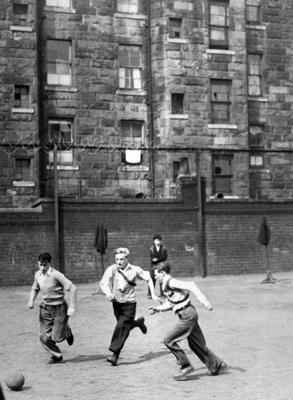"Synthetic Pleasures" Techno-Revolution or Just Another Dystopia?
Is reality obsolete? From low-tech function like body piercing and artificially-stocked fishing pools, to the latest in bionics and VR gaming, Iara Lee's cyber-age intellectual survey - call it a *.DOCumentary - downloads a Future Shockful of data and defines the parameters of advanced technologies that delete nature and reprogram mankind. Cryonics defy death; the Internet exists outside time and space; smart drugs and surgery upgrade the mind and body. But are we headed toward human optimization, or system crash?Timothy Leary, RU Sirius, Lisa Palac, John Barlow and others offer sound bytes against a mesmerizing screen display of cutting edge computer-graphics and archival clips. Exhilarating and disturbing, Synthetic Pleasures raises issues nobody today can afford to abort / retry / ignore.
.jpg)
George Gund presents
a Caipirinha Productions film
Synthetic Pleasures
directed by Iara Lee
"Synthetic Pleasures" Techno-Revolution or Just Another Dystopia?
September 1996
Issue 17 © Stefan Mattessich
At the 1996 San Francisco International Film Festival screening of Iara Lee's Synthetic Pleasures, Lee and her husband, producer George Gund, fielded questions from an audience troubled by the film's celebration of digital technologies, virtual reality, and cyberspace. The documentary, which presents a barrage of computer-generated art, film clips, and interviews with animators, writers, and scientists, left some viewers wondering aloud about the alienating consequences of the "digital revolution" in our time. Lee's response was measured, and she expressed her hope that the film was balanced enough in its presentation to spark a constructive dialogue on the changes brought about by the new technologies she showcases.

Synthetic Pleasures is more than provocative enough to do that. Its frenetic swirl of energy, music, and articulate commentary adds up to a stunning argument for the decisive impact of technological change on the environment, on our bodies and minds, and on a basic sense of self-identity. The segment with French performance artist Orlan, whose "struggle against nature" leads her to alter her own body through plastic surgery and silicon implants, provides a visceral example of the film's basic idea: the tension between nature and artifice, between an untamed environment and a human need for control, leads to a serious crisis in what we mean by the human, the natural, and the artificial.
This crisis is at the same time what is troubling about Lee's film. With all that Synthetic Pleasures is able to suggest visually about the scope of this crisis in its depiction of virtual spaces like Japan's Ocean Dome, to that degree Lee deprives us of any stable or "real" alternative that might counter our seemingly inexhaustible desire for things simulated. The virtue of the film is that it complicates this desire from both ends. It acknowledges the detachment from experience and from the consequences of our actions that follows upon a simulacra abstraction from the environment, and it intelligently presents the abstraction that the "human" already is for those artists, body piercers, and transsexuals who rebel against the gendered organization of the body, of the "organism" that we are and that never has been "natural" apart from very specific cultural norms.
Director Iara Lee
If there is a shortcoming to the film, it turns on its failure to draw a clear distinction between the two modes this desire takes. To want a virtual reality that suggests abstraction is not the same as refusing the abstraction of a reality that is essentially constructed, even if both modes are possible in the same desire. Indeed, since the difference that needs emphasizing here is not of kind but of modes, Lee cannot say that the desire for the virtual reality of a Las Vegas casino, for instance, differs fundamentally from the desire to change one's gender, even though one implies acquiescence to a consumerist society and the other a refusal of social norms deemed intolerable. "Synthetic pleasure" is common in both instances, and this central premise of Synthetic Pleasures is compelling as long as one does not also equivocate the modal difference. There are times when the film seems to lose its focus on this point, and the result is a breakdown in its own synthetic logic. Instead of centering for the viewer a world that is intrinsically virtual, even at the level of human biology and the structure of matter, the film in effect fissures the real and the virtual all over again, falls back to a stable definition of nature from which virtual reality can only be seen and entered into as its secondary or derived imitation.
When this happens, the film no longer clearly foregrounds its own most interesting idea that nature is simulated. It can then either criticize or celebrate consumer societies hooked on virtual reality, but it cannot grasp the pleasure of that addiction. And it can either reject or sustain the diagnosis of alienated desire, but it cannot see the way desire in the world it constructs actively resists is own social repression. This is why the film occasionally suggests condescension toward its more marginal subjects--teenagers, clubgoers, transvestites, transsexuals--and also why it might seem to filmgoers an overly optimistic portrayal of "cyberculture."

But in fact Synthetic Pleasures is not an optimistic portrayal. If it seems that way, it is because it wants to understand the virtual character of reality and the synthetic character of pleasure without prying them apart again. When it fails in this respect, it does so by falling back on a social, psychological, or material reality that is only real, and so constructs the virtual as a shadow or double of our experience that we can only passively consume. But the interesting wager of the film is that any reduction of this kind obscures the nature of desire, and indeed constitutes the very technological drive that alienates us from our environment and from ourselves. The balance Lee seeks in Synthetic Pleasures presumes this possibility of genuine insight into our technologically sophisticated society, and for this it should be seen and discussed in the spirit Lee hopes it will be.
SYNTHETIC PLEASURES was shot on location in Yokohama, Tokyo, Miyazaki, New York, Boston, Las Vegas, Orlando, San Francisco, Walnut Creek, San Jose, Berkeley, San Diego, Los Angeles, Detroit
Mankind's ability to tap Nature's power has recently achieved such success that a new world is suddenly emerging, an artificial reality.
-- Benjamin Woolley,Virtual Worlds
The fantasy is that we can somehow transcend our horrible condition of being human through these shining black boxes.
--Jaron Lanier
> SYNTHETIC PLEASURES Production Notes <
Synthetic Pleasures begins with a montage of images which takes the viewer on a high-speed trip through natural landscapes, cultivated landscapes, simulated theme park jungles, indoor beaches and ski slopes, etc., before finally penetrating a computer screen to reveal a digitally-enhanced virtual landscape, a glowing simulation of the natural forests and beaches which initiated the sequence.An opening narration considers the human drive to control nature and to overcome the limitations it imposes upon us. Some of the film's key interviewees are introduced, each elaborating upon the idea that we have recently entered a new technological era, an historical phase where technological innovations have given us access to seemingly unlimited powers of transformation. These powers include the ability to transform:
- our environments: virtual reality, synthetic environments from the shopping mall to Biosphere, etc.
- our bodies: genetic engineering, plastic surgery, etc.
- our identities: smart drugs, mood-altering drugs, etc.
The final section of Synthetic Pleasures deals with broader perspectives on our relationship with technology, where this relationship is taking us and what its implications will be for the future.This four-part schema will serve as a guide for the greater part of the film, a loose way of organizing the film's investigation of often inter-connected, cutting edge technologies. Interviews will provide technical information, but will emphasize the influence of technology on human experience and question the implications of having access to so much transformative power.Synthetic Pleasures relies extensively on both images of technology and technologically-produced images. Ambient and techno music will provide the soundtrack.
Synthetic Pleasures (1995)
Soundtrack
Fat Chair by Terre Thaemlitz
Hovering Glows by Terre Thaemlitz040468 by Terre ThaemlitzWet Moon by Human Mesh DanceSoft System by Human Mesh DanceA Thousand Dyes on the Moist Earth by OmicronDevil Dog by Prototype 909Beacon 08 by SetiBeacon 14 by SetiAlcove "Question of Trust"Written and Produced by Laurent JadotTransformer 2 "Virtual Cocoon"Written and Produced by Jeff Hypp
DJ Bubba "Dream Planet"Written and Produced by DJ Bubba
Karma De La Luna "Travel without Moving"Written and Produced by Shai de la LunaMan-dello "Shomyo"Written and Produced by J. M. Ledermen & C.S. Johansen
Jaydee "Think For a While"
Written and arranged by Jaydee
Cantamilla by Tranquillity BassI'm So High by Tranquillity BassMya Yadana by Tranquillity BassPurdy Deyenol Written and Performed by TylerVisionCoalesce by ESSA3Sundial by ESSA3
Transmit Liberation performed by Single Cell Orchestra
Written by Miguel Fierro
Confuss Music by Hardfloor
Written and Performed by Pete Namlook
Impossible ReligionWritten, recorded and produced by John Cameron
Trance Formation
Written and Produced by Young American Primitive
Over and Out
Written and Produced by Young American Primitive
Eis by Darrin Verhagen courtesy of Dorobo
Heliotherapy
by [NDE] Haruomi Hosono + G.Hotoda, B. Laswell, Y. Terada
Strange Attractor
by [NDE] Haruomi Hosono + G.Hotoda, B. Laswell, Y. Terada
Taste of Your Own Medicine by Justin King
Mafich Arabi Performed by Banco de Gaia
For a Pavilion of Wind & Cloud-Atalanta by Kenneth Newby
Japanese Cherry Blossoms by Global Dance Project
Tongues of Fire by Air Liquide
Written by Jammin' Unit Walker courtesy of Sm:)e Records
To learn more about Moonshine Music read their mission statement via The Way Back Machine
Check out a recent project from Caipirinha Productions
ALSO BY IARA LEE














.jpg)





